Bathroom plants are a great example of how plants actively improve our lives. Not just by looking good, but by looking after us and our homes too. Whether they just grow well in that environment, or actively absorb excess moisture, and clean the air around us, it’s well worth growing your own bathroom plants.
We’ve chosen thirty of our absolute favourite plants for bathrooms, and shed some light on what makes them such a great addition to your home.
More...
What is a Bathroom Plant?
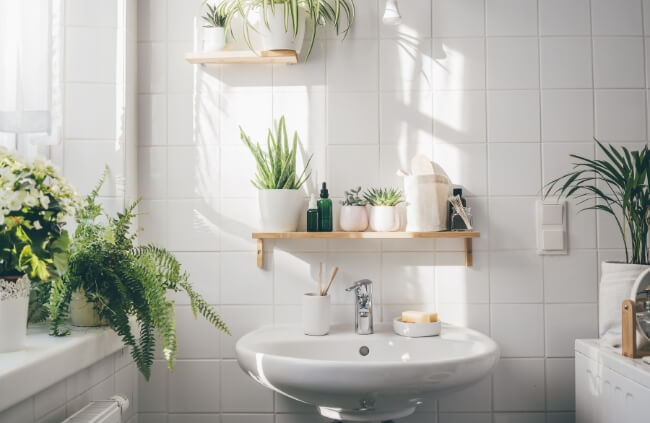
Bathroom plants are, basically, just plants that grow in your bathroom. But that’s not the interesting part. The clever bit comes when we dive into why they grow well in that type of space, and what their health means for you as a homeowner.
Bathroom plants enjoy humid conditions. They build a relationship with their space, by hanging or growing in the direction of the light, and in some cases, away from it. They make the most of challenging spaces and sometimes absorb so much humidity from steamy showers that they reduce dampness, and improve air quality too.
What Type of Plants Grow Best in Bathrooms?
The best types of plants to grow in bathrooms are those that feed from humidity, and like constant moisture, but relatively rare watering. It’s an odd combination, but the most important part comes from an innate relationship most of these plants have with their natural habitats.
Why Do Some Plants Thrive in Bathrooms?
Some plants that thrive in bathrooms are tropical, and others hail from more temperate parts of the world, but the majority are forest plants, which have to compete with taller, more robust plants, for water.
They do this either through water capture in cup-shaped leaves, the presence of aerial roots, wider, better-adapted leaves that can soak in every last drop of rain, or simply by having smaller, less demanding leaves to begin with.
Every plant that copes well in humid bathrooms is different, but nearly all forest plants will do well in bathroom settings. The next trick is understanding how your bathroom differs from your neighbours.
Light levels will be different, ventilation will shift, and both of those will affect temperatures and humidity. All of which should be a deciding factor in what plant you choose, and why.
How do aerial roots help plants in bathrooms?
Aerial roots, like those on Monstera, Pothos and English Ivy, have two main functions. Function one is anchorage, generally trying to find loose bark, or rock to cling to as support for climbing plants.
Function two is the most important (as aerial roots will generally grow healthily without an anchor in most cases). These roots, which can be as thick as the stem in many cases, absorb humidity from the air.
In bathrooms, that means that every shower, every hot bath, every steamy sink, waters your plants.
How do large leaves help plants in bathrooms?
Large leaves are a good indicator that a plant will cope well in a bathroom, but isn’t a true rule. Some plants with large leaves actually hate humidity, but some, like Monstera (with ventilation added) work brilliantly.
This is because, similarly to aerial roots, humidity settles on their large surface, which is marginally cooler than room temperature, and is then channelled down leaf ridges, along petioles, and down stems, to the soil.


Get Your Free Guide:
Master Growing Australian Natives eBook
A Must Have Complete Guide for Every Australian Garden
Get Your Free Guide:
Master Growing Australian Natives eBook
A Must Have Complete Guide for Every Australian Garden
They also make particularly good use of low light as they maximise photosynthesis. In some cases, this is because of competition in nature, as they need to gather every last drop of sunlight through overhead tree canopies.
How do small leaves help plants in bathrooms?
Plants with small leaves, papery leaves, or sword-shaped leaves are often equally well adapted to bathrooms but, again, this is not a rule to live by, and comes with many caveats.
Firstly, papery-leaved plants can be incredibly susceptible to fungal problems, and excess humidity can rot the leaves, and the roots quite quickly. However, some, like spider plants, have thin, sword-shaped leaves in tight rosettes, which in humid settings send off long runners, with a series of smaller plants attached.
These smaller plants have individual roots that can survive on humidity alone. String of Hearts works in a similar way.
30 Bathrooms Plants to Choose From
1. Swiss Cheese Plant (Monstera)

All variants of Monstera are brilliant choices for a humid bathroom. The original trendy Swiss Cheese plant with its large glossy leaves can happily climb up a moss pole and surround your equally on-trend claw foot bathtub.
Monstera are rainforest floor plants adapted to low light conditions and humid atmospheres, their long aerial roots will trail out in all directions and, in nature, cling and climb to help support themselves.
This may not be a totally necessary task in your bathroom due to your brilliant plant care and regularly tying in your monstera to its moss pole, but before you prune those aerial roots away, it's important to know that they help toward the overall health of your plant.
Monstera aerial roots will continue to absorb moisture in the air keeping the plant hydrated and healthy and keeping your bathroom damp-free.
2. English Ivy (Hedera helix)

English Ivy just looks after itself and looks after you by filtering the air you breathe in your bathroom. Hanging ivy high will show off its ornamental vines, and it will even thrive in that problematic shady corner.
3. Aloe Vera
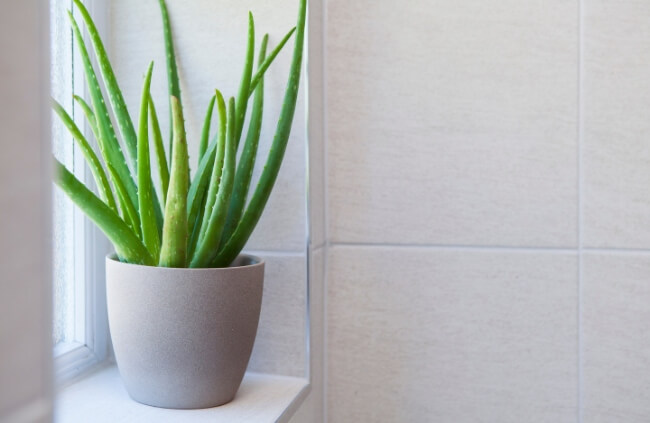
Although a succulent, Aloe Vera is a perfect candidate for a humid bathroom, as long as it has good drainage and good light. It likes to be watered deeply but infrequently and allowed to dry out as those spongy leaves hold so much moisture already.
A humid environment allows for less transpiration of their vital leaf moisture and keeps the plant healthier with plumper leaves. Aloe is known also to be an air-purifying plant as well as a skin soother. It is a total all-rounder.
4. Shield Plant (Homalomena rubescens)
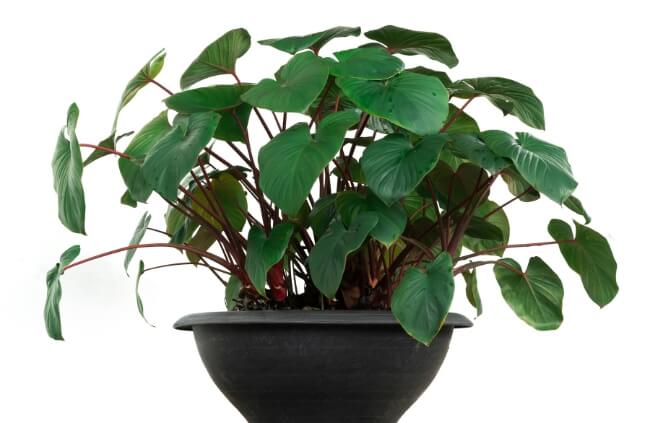
An uncommon houseplant but well worth the space in your home if you happen across it. The shield plant likes a humid spot to stretch out its large shield-shaped leaves.
Homalomena rubescens also wants to be protected from bright light as it can have sensitive leaves so maybe a slightly dappled shaded spot in your bathroom.
Explore our in-depth guide to growing Homalomena to learn more about this plant..
5. Air Plants (Tillandsia)
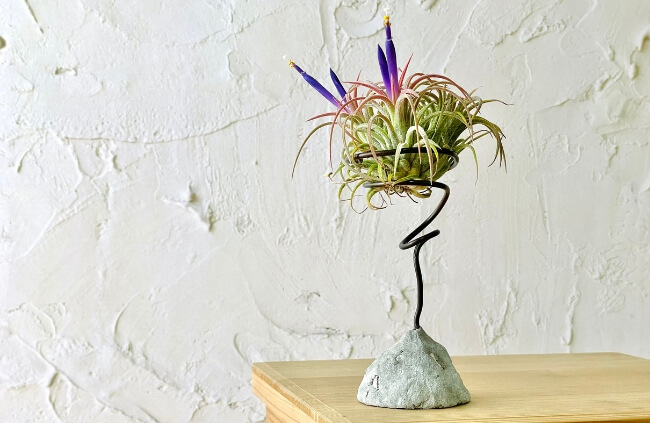
Air plants are for you if you have trouble keeping your houseplants alive, they take very little care and seem to just survive no matter what. Tillandsia are epiphytic so grow without roots, they would naturally anchor to another plant and have no need to take up water through the roots.
Instead, they absorb all they need to thrive through the water in the air meaning a misty bathroom is perfect.
6. Snake Plant/ Mother In Law’s Tongue (Sansevieria)

The Snake Plant has a reputation for being incredibly hardy, and very difficult to kill as it can handle infrequent watering and low light, and it seems to thrive in bathrooms, making it one of just a handful of succulents that will.
Their long fleshy leaves hold the water they need to survive like all succulents and being in a humid environment will help the retention of that water through minimal transpiration. In turn, the snake plant will also help clean the air in your bathroom too.
7. Bromeliad

Another epiphytic plant, Bromeliad, attaches itself to other plants and trees with roots but doesn’t really take up any water or nutrients through these. Instead, they collect rainwater in their rosette which filters through slowly and feeds the plant.
In their natural environment, bromeliads can be homes to frogs or other water-dwelling creatures as the mini ponds are safe nutrient-rich habitats. Essentially bromeliads are perfect for bathrooms, they would even love to be showered themselves from time to time.
8. Mistletoe Cacti (Rhipsalis)
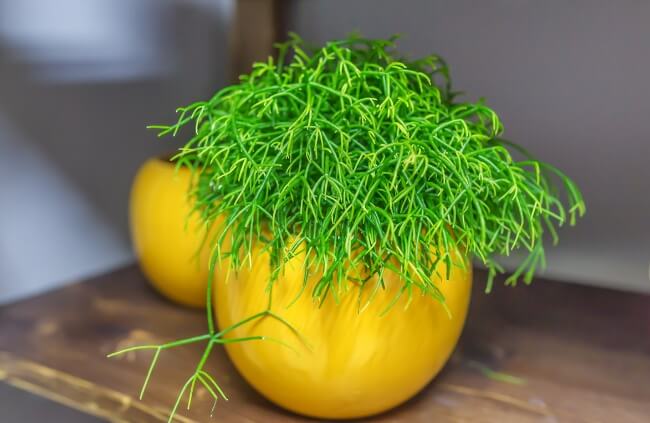
The Mistletoe Cactus may sound like it shouldn’t belong in a typical bathroom setup. Cacti like to be dry and baked in the sun. However, Rhipsalis is not at all typical and actually prefers higher humidity and lower light levels so would be perfect for a bathroom.
The perfect spot for mistletoe cactus would be hanging over somewhere like the shower or sink where it could benefit from the rising humidity without the risk of getting any water-logged roots.
Its unusual dreadlocks of leaves that cascade down will be a focal point in any modern bathroom.
9. Sword/Boston Fern (Nephrolepis exaltata)
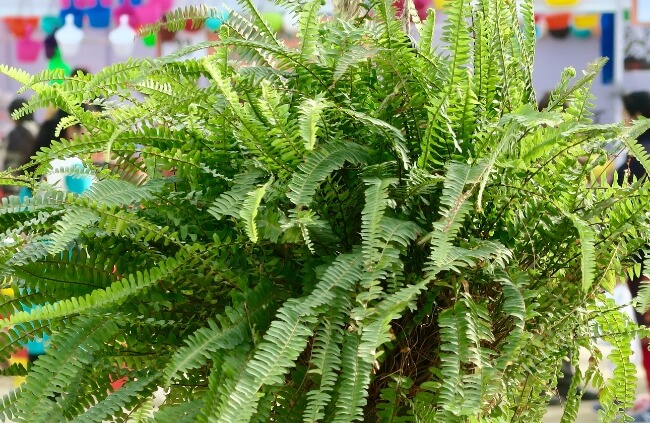
All ferns are perfect for darker, more humid situations, and in nature, a rainforest floor can be littered with ferns because of that perfectly balanced humid ecosystem.
The Boston fern in particular is also pet safe, so if you have a cat like ours that licks everything he finds in the bathroom, this fern will put your mind at ease.
10. Orchid
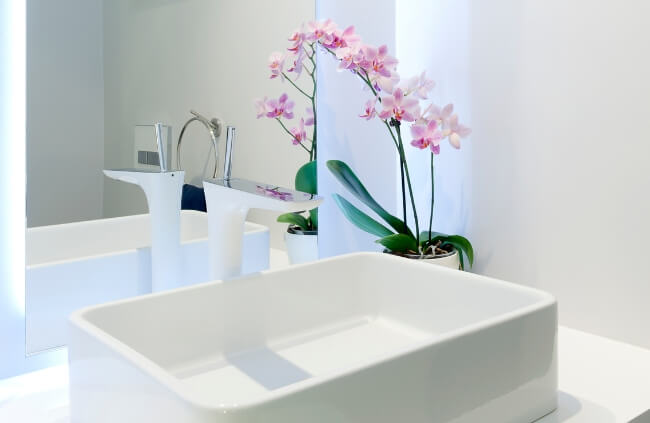
Orchids are tropical plants that thrive in humidity. Most orchids are epiphytes and when store-bought often come in clear pots where you can see the roots. These are the aerial roots that the plant would use for anchorage.
Orchids often have a reputation for being sensitive and dying as a houseplant but this is often through misunderstanding their preferred habitat and overwatering into the pot that houses all the aerial roots.
Like all other epiphytes, most orchids absorb water in the air through their leaves.
11. Peace Lily (Spathiphyllum wallisii)
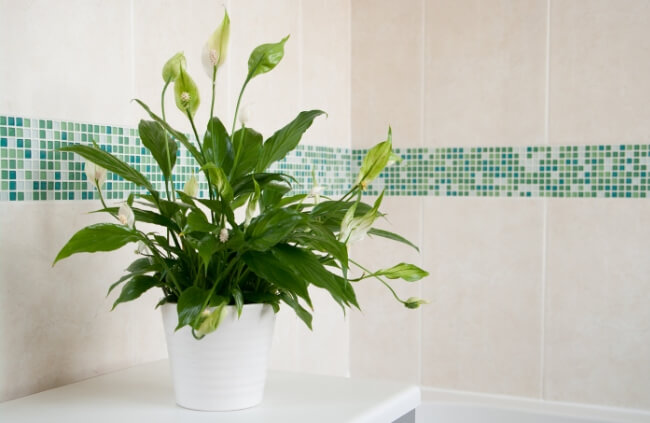
The Peace lily is a stalwart of a houseplant but may not come to mind immediately for that plant void in the bathroom. However, it is perfect for humid spaces and it is claimed that it reduces mould and mildew due to how much moisture it can absorb from the air.
12. Devil’s Ivy/ Pothos (Epipremnum aureum)
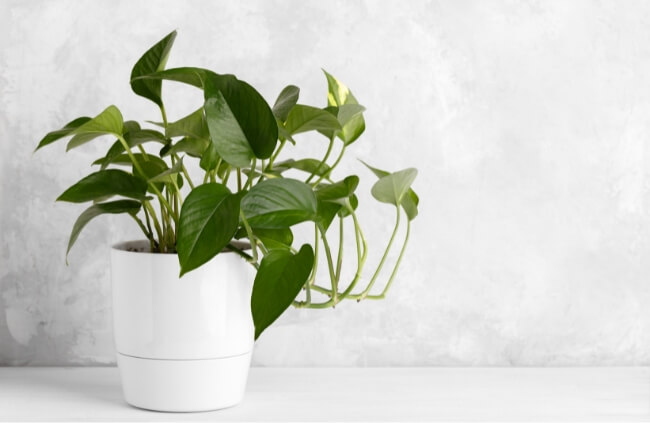
Devil’s Ivy, for us, is the ultimate bathroom plant. We have a mature specimen growing up our bathroom wall and it couldn't be happier thriving in the mid-bright location we have.
They don't require any special care other than a slight bit of control as if left to their own devices, Devil’s Ivy would, I think, take over the world. We originally bought ours attached to a moss pole but it quickly outgrew that.
Some simple stick-on-wall hooks we found to support the vines worked really well and, just like Monstera, the plant will produce its own aerial roots which are very effective at sticking themselves to the wall or anything else you provide for support (which, don't worry, won’t harm your tiles).
13. The Prayer Plant (Maranta leuconeura)

The decorative prayer plant will give your bathroom plenty of interest with its patterned leaves that close at night. Maranta are well suited to bathrooms and humid spaces with consistent temperatures.
If you place your prayer plant in a bathroom it will love the warmth and moisture of your shower and reward you with its stunning foliage.
14. Inch Plant (Tradescantia)
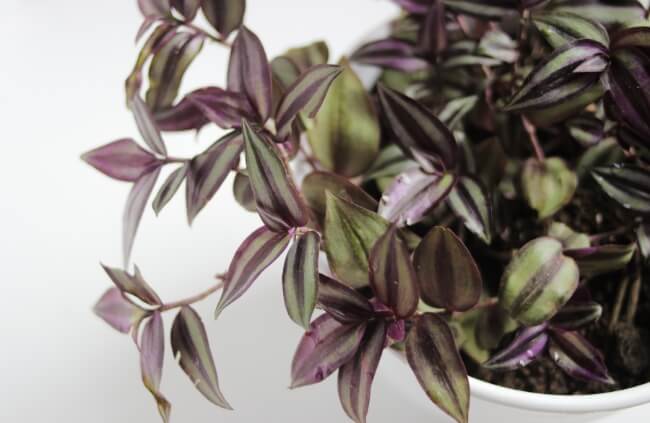
The best thing about Tradescantia is that they will adapt to your space, they are brilliant at coping with a bit of neglect. However, if you want your inch plant to thrive, the prime location will be in your bathroom where it will enjoy that extra humidity.
Inch plants would naturally creep their way across the soil rooting as they go, so they happily root from their stems. In humid environments, your Tradescantia will create new roots from the stem absorbing all that extra humidity and keeping the plant healthy.
15. Pilea
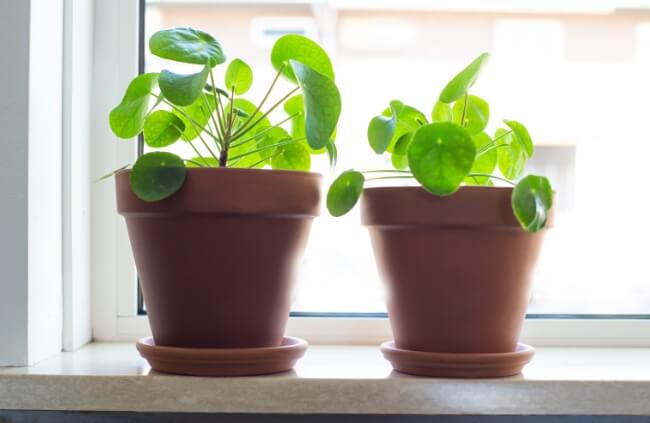
Whether you have a Chinese Money Plant or trailing Himalayan Pilea, the bathroom is a great place to display these tropical weather-loving plants. We have a Himalayan trailing pilea hanging in our bathroom above a sink that has thrived in this location and happily rooted itself into a neighbouring pot.
16. The Nerve Plant (Fittonia)
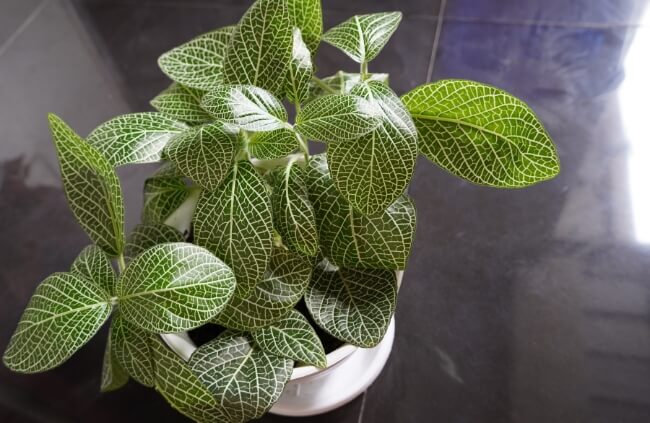
This terrarium-friendly plant is at its happiest in a humid space, terrariums offer the most accessible humidity to keep it at its healthiest. The next best place for the nerve plant would be a warm and humid bathroom.
If a fittonia is lacking in moisture its small decoratively veined leaves will suddenly droop so a constant supply of water in the air will keep it happy and hydrated.
17. Flamingo Flower (Anthurium)
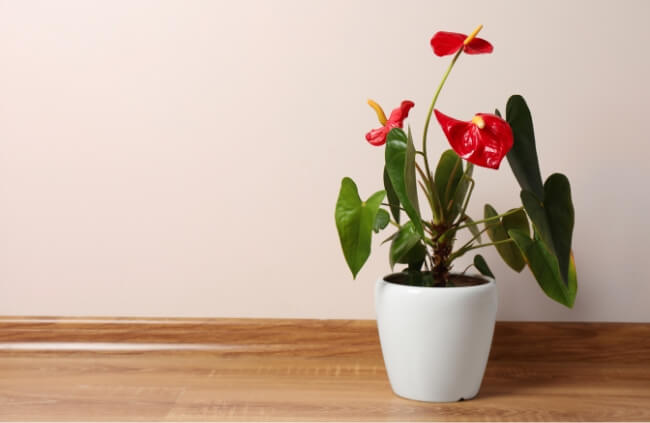
What better way to decorate your bathroom than with the exotic and vibrant flowers of the anthurium? Flamingo flowers love humidity to keep their glossy leaves shiny and vibrant.
Placing your anthurium in a warm and bright spot near your sink or bath will keep it flowering its socks off.
18. Polka Dot Begonia (Begonia maculata)
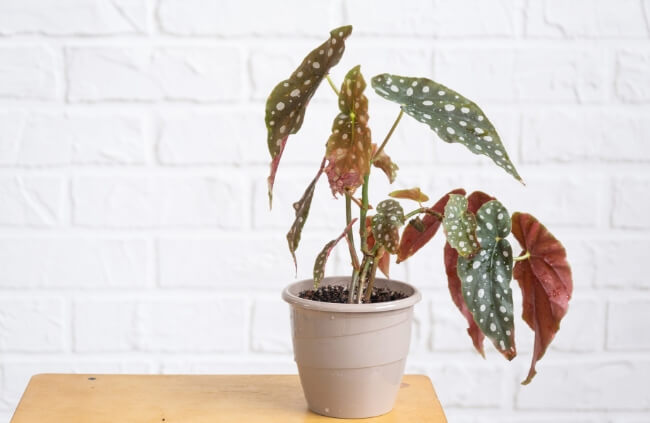
Originating in the Brazilian rainforests, the Polka Dot Begonia thrives in a warm and humid spot. Given the right conditions, your begonia will reward you with beautiful exotic white flowers.
19. Colocasia

Colocasia are lusciously leaved plants that can have foliage colours anywhere from green, to pink and white, or even purple and black. They grow from tubers and are happiest in moist, humid and warm places to keep their delicate papery thin leaves healthy.
When growing colocasia as a houseplant, they may drop their leaves over winter if the plant gets too cold, keeping it warm throughout will maintain that foliage.
20. ZZ Plant (Zamioculcas zamiifolia)

Known simply as the ZZ plant, this unique and charismatic plant is hardy and hard to kill so can adapt to the environment you have it in. It actually doesn’t need a great deal of light so you can put your ZZ in a darker corner in your bathroom and it should grow away happily.
The easygoing ZZ plant would even tolerate low humidity but if you want your ZZ to have those dark glossy leaves on lots of long stems then the extra humidity that a bathroom will give will make for a healthier, bushier plant.
21. Philodendron

There are so many interesting types of philodendrons that would love the bathroom environment. We have the lovely variegated Philodendron ‘White Wizard’ in ours. They seem to love the warmth and humidity that arise from the bath, and the glossy leaves give the bathroom a real spa-like feeling.
You’ll feel ever more like you’re on a spa day when you find out that your philodendron is cleaning the air in your bathroom for you.
Check out our philodendron growing guides below:
22. Guiana Chestnut/Money Tree (Pachira aquatica)

The houseplant is noted most for its thick intertwined trunk that can resemble a braid. The Money tree is a beautiful bathroom floor plant, and those palmate leaves that are so architectural in modern spaces help to add elegance to the room.
In its natural habitat, the Money tree would grow in tropical wetland swaps, so it's happiest within a humid little ecosystem, your bathroom is really the next best thing!
23. Japanese Aralia (Fatsia japonica)

Also grown as a houseplant, Fatsia are seen indoors just as often as they are found in outdoor gardens. Absolutely ideal for a bathroom as humidity is a must for Fatsia, they also don’t mind a bit of low light.
With their large rainforest-typical leaves, your bathroom will feel like a tropical oasis.
24. False Shamrock Plant (Oxalis triangularis)

Oxalis are happy growing both indoors and outdoors and do like a nicely humid atmosphere. Their fascinating leaves close up at night which is part of the plant's natural rhythm so keeping your plant by a window so it can get some daylight will allow it to freely react to light as it wishes.
We have a healthy oxalis growing inside our greenhouse and it obviously loves the wet and humid atmosphere it provides, so a bathroom would be perfect for any oxalis.
25. Dumb Cane (Dieffenbachia)
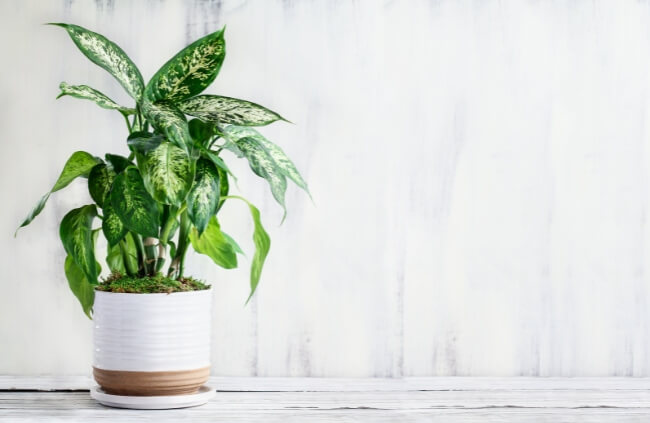
The dumb cane plant absolutely thrives on humidity, it’s a real must for this plant to be happy. Placing a Dieffenbachia in your bathroom, in a warmer spot with a consistent temperature, will make sure that this beautiful tropical plant stays healthy.
26. Lipstick Plant (Aeschynanthus radicans)

A beautifully flowering showstopper of a houseplant is the lipstick plant. Its long red salvia-like flowers cascade down and display an abundance of colour when hung in your bathroom.
Lipstick plants love humidity so hanging above a sink or bath will give it the humid boost it craves, especially important in winter when our homes have heating and the indoor environment becomes much drier.
27. Fiddle Leaf Fig (Ficus lyrata)
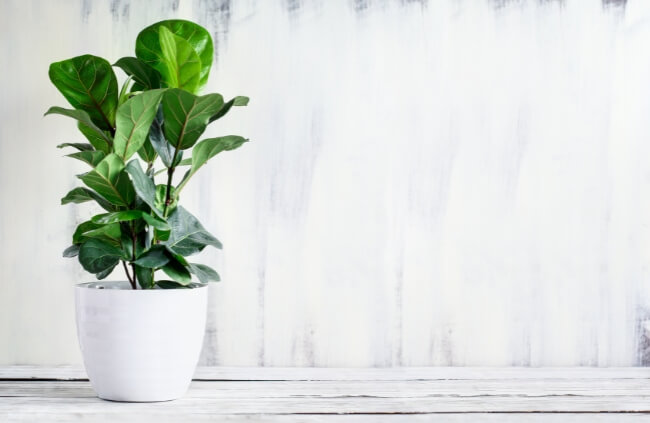
These large-leaved fig plants may not need as much humidity as other house plants but they will definitely benefit from the extra ambient moisture in your bathroom. The large leaves will have less transpiration in humid conditions so will be more supple and hydrated.
Your fiddle leaf fig will need good drainage and ventilation to help with the extra humidity.
28. Trumpet Pitcher Plant (Sarracenia)

If you’re looking for something a little more unusual for a new bathroom plant, why not try a carnivorous Sarracenia, also known as a fly trap? These weird and wonderful plants will fascinate you and they generally look after themselves.
Placed on a sunny windowsill with a tray of clean water under the pot, they will absolutely thrive. Flytraps like to have their feet in water consistently as they originate from swampland.
Flytrap plants will thrive in the humidity your bathroom gives. Plus, they have the added benefit of controlling any unwanted flies.
29. Spider Plant (Chlorophytum comosum)
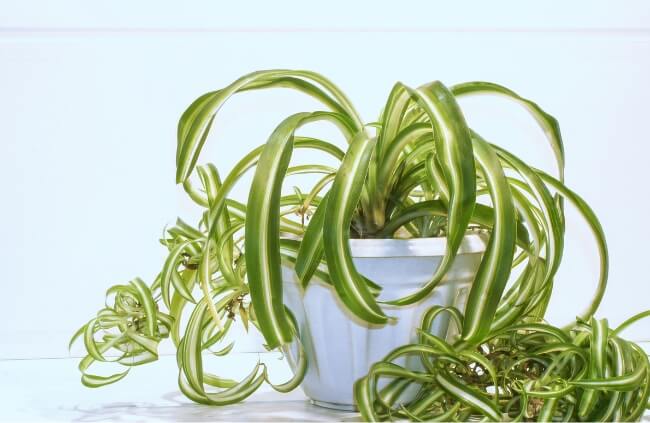
Spider plants are one of the easiest houseplants you can grow. They look after themselves and even propagate as they please. Spider Plants will thrive in humid environments where they can absorb excess steam and water from the air.
When displayed in a hanging planter or plant pot that can trail over a window ledge or shelf, spider plants will give you lovely delicate flowers on long stems that reach out of their narrow striped leaves.
Spider plant flowers will then turn into ‘spiderettes’, these will produce their own roots in humid conditions and without any effort on your part, you have new plants. These plantlets look beautiful hanging down from your original specimen giving your bathroom a tropical, rainforest vibe.
30. Dragon Plant (Dracaena)
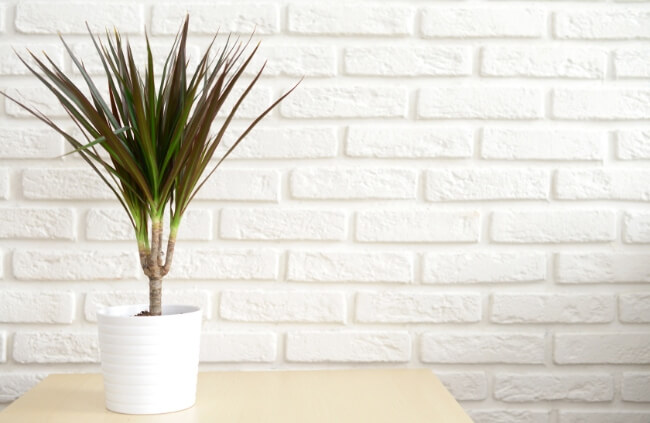
Dragon plants often have long pointed leaves, these leaves really do benefit from a slightly more humid area in your home like the bathroom. The extra humidity keeps leaf tips from browning and keeps that luscious leaf lustre.
Caring for Bathroom Plants
Most of the plants in the list above (not all) like quite similar conditions. To make life easy, there are some simple rules to follow for preparing your soil and choosing the right containers, that will help most of your bathroom plants grow happier and healthier.
Best potting mix for bathroom plants
It might seem counterintuitive to give humidity living plants drainage, but it’s important to stop root rot and ensure the soil can dry out intermittently. The soil nutrients you choose should always be decided by the plant itself, but in general, a reasonably good organic compost, with a soil base should form the base of your potting mix.
Add at least 30% grit or perlite to the mix to add long-term drainage, and aerate the soil. Before planting, add a few crocks, or even chunks of polystyrene to the base of the pot so that the planting hole doesn’t get blocked, and can drain freely.
If you’ve got it, add a thin layer of grit to the surface of the pot. This will help to reduce pests and mould and stop soil from drying out at the very surface too.
What container to use
Plastic containers or glazed ceramic pots are best for bathroom plants. Never plant bathroom plants in terracotta (unglazed ceramics). Terracotta is a useful indicator of soil moisture in the garden, and for other houseplants too, but in bathrooms it will invariably develop a layer of powdery mould, and rather than draw moisture out, can draw it in from the air.
Light conditions for bathroom plants
All bathroom plants need different light conditions. Some thrive in very low lights, and others need to be right on the windowsill with as much light and heat as they can get.
If you’re not sure what light conditions you have in the bathroom, or you’ve just moved in, check in at different times of day to see where the light and shadows fall. Avoid direct afternoon sun for most bathroom plants, instead, offering them spots with good morning, or late afternoon sunlight.
Ventilation for bathroom plants
Despite their love of humidity, bathroom plants like ventilation. Humidity should be brief, and routine, followed by dry periods for the plant to process its moisture, before getting wet again.
This can be as simple as cracking a window, turning on a bathroom fan after a shower, or installing passive vents above windows.
Common Bathroom Plants Problems

Regardless of the plants you grow in your bathroom, some fungal problems are inevitable. At some point, every plant grown in a bathroom will succumb to verticillium wilt, and others will suffer from root rot – particularly through winter.
The temperatures in our homes drop through winter. Central heating dries out soil, but humidity stays the same as we use our showers just as we do in summer. Light levels drop, and plants just aren’t designed to cope with these artificial settings.
But, with a very small amount of attention paid to your plants, you can prevent, treat, and stop these troubling problems in their tracks.
Problems When Growing Bathroom Plants
The most common problem with bathroom plants is damp soil. You will often find that soil remains moist for weeks at a time, without the need for watering.
For some plants, this is OK (Devil’s Ivy, or English Ivy, for example, are well adapted to these conditions). For others, it’s a death sentence. Aim to maintain ventilation, so that between baths and showers, your bathroom plants are allowed to dry out.
If the soil is noticeably damp between watering, make sure the pot is raised slightly from the floor or drip tray, so water can escape. Move your plant somewhere slightly bright too. This might mean keeping the pot in bright light, with shade for the plant itself.
Pests & Diseases to Look Out For
Fungal problems, particularly verticillium wilt, are common with all bathroom plants. Fungal spores take hold of damp leaves and infect any damaged tissue. To prevent it from happening, remove any damaged leaves when you see them.
If you notice roughly V-shaped yellow markings, which develop into larger lesions, with brown edges, at the edge of a leaf, just remove the leaf to prevent spread. Feeding with liquid plant food once a month through summer and autumn will help to prepare your plant against infection too.
Note: The most common preliminary cause of fungal infection is pest damage. Mealybugs thrive in bathrooms, particularly on damp soil. Scrape off any pests you see and flush them away. Treat leaves with neem oil sprays occasionally to discourage pests.
Bathroom Plants Frequently Asked Questions
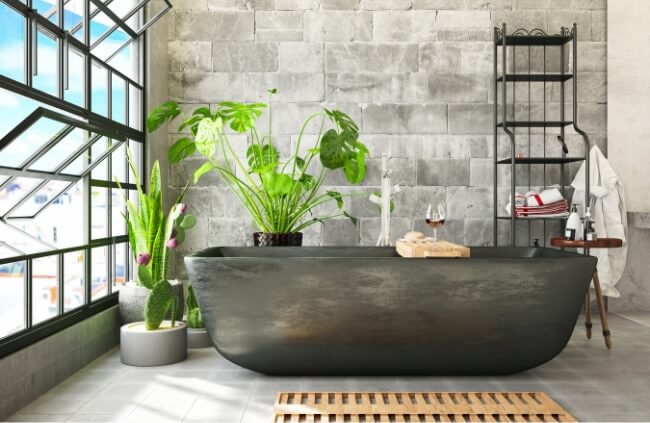
What plants are good in bathrooms with no light?
Philodendrons and ferns work well in bathrooms with no light. Obviously, they still need some access to sunlight and ventilation, but they enjoy humid conditions and don’t mind being in the shade for most of the day.
What plants stop mould in the bathroom?
English ivy is one of the most effective mould-preventing plants for a bathroom, but it does need controlling, and growing away from plastered walls, as its roots can damage the paint.
However, if you find it the right home, it absorbs more airborne chemicals than any other plant and sucks every last drop of steam out of the air that it can.
What is the easiest plant to grow in a bathroom?
Spider plants are the easiest plants to grow in a bathroom. They can cope with most light conditions, love the humidity, and with a single annual prune (of which, most cuttings can be turned into new plants) you can keep them looking beautiful all year round.
Do snake plants like bathrooms?
Snake plants are often sold as good bathroom plants, but they are incredibly susceptible to mould, and should never be sat in damp soil. If you do grow snake plants in your bathroom, make sure they are given exceptionally well-drained soil to balance the humidity.
How do I add plants to my small bathroom?
Many bathroom plants are best grown in hanging pots, meaning you can grow them well in small bathrooms. They take up little to no space and can hang easily from the ceiling, or wall hooks.
Wrapping Up Our Bathroom Plants Guide
Bathroom plants are incredibly easy to care for once you’ve got their conditions right, and they actively reduce humidity in the room by soaking up as much of it as they can get their hands on.
Spider plants are always the most visually striking, dangling down from shaded shelves to spots where they can get light, and often creating their own perfect propagated plants, ready to plant elsewhere in the house or garden, but you can achieve beautiful results with most bathrooms plants. So, what are you waiting for? Green up that room.
Published on October 9, 2023 by Gary Clarke
Last Updated on September 20, 2024




